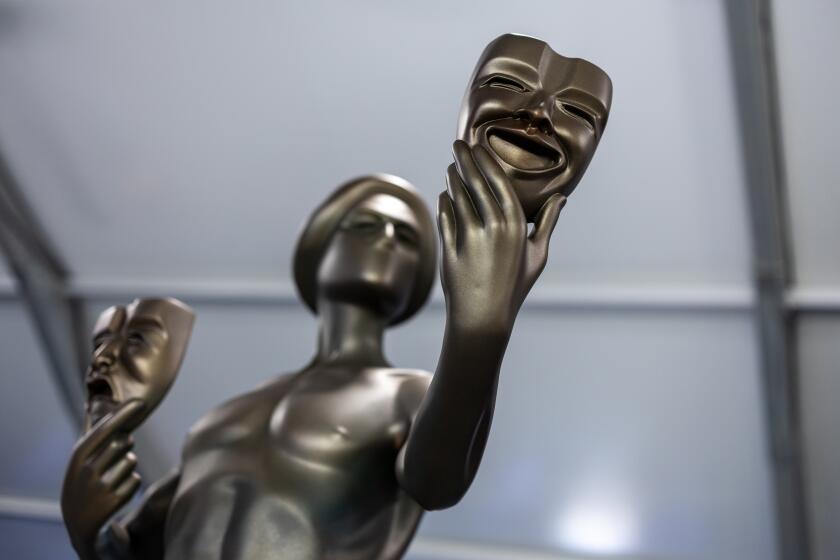Hollywood has long shown discomfort with interracial couples, but change is happening
- Share via
In 1967, the same year the Supreme Court case Loving vs. Virginia struck down laws banning miscegenation, Sidney Poitier starred in “Guess Who’s Coming to Dinner” as a black man romantically involved with blond Katherine Houghton.
Yet in both real and reel life, black-white romantic relationships were problematic, fraught with legal and social taboos. In the case of Loving, that meant rural Virginia couple Richard and Mildred Loving, who married in Washington, D.C., in 1958, were arrested in their home state, forced to move away or be jailed, and spent years fighting the racist law that affected them until the Supreme Court unanimously overturned it.
“The fact any miscegenation laws even existed, these are vestiges of slavery,” says Jeff Nichols, director of “Loving,” a new film based on the famous case starring Joel Edgerton and Ruth Negga. “All of this speaks to the institutionalized racism in the South.”
“Guess,” which was released six months after the Loving decision, was, in its own way, meant to be a liberal antidote to situations like this. In director Stanley Kramer’s film, parents and friends of the romantic couple discuss the pros and cons of their romance in a civilized manner until the woman’s father (played by Spencer Tracy) gives his blessing to the relationship.
But there are no big love scenes in the film, and it “shows Hollywood’s fear of a black man with a white woman,” says Donald Bogle, author of “Elizabeth and Michael: The Queen of Hollywood and the King of Pop,” as well as several books about African Americans in Hollywood.
“Poitier’s character in that film is so perfect – he’s a doctor -- but the film still questions if he’s fit for this white woman,” adds Bogle. “It’s not dealing with the reality an interracial couple might have to face.”
This refusal to deal with the reality of interracial love and sex is nothing new; it’s pretty much how the movies have handled these relationships down through the years. Beginning with D.W. Griffith’s 1915 racist depiction “The Birth of a Nation,” in which, as described by NYU film professor Sam Pollard, “the black man was this evil beast defiling white womanhood (in one scene, a white woman commits suicide rather than be ‘violated’ by a black man),” Hollywood has tiptoed around, or outright ignored, realistic depictions of interracial romance.
“During the classic Hollywood era, the industry was regulated by the Production Code, and it banned depictions of miscegenation,” says Ellen Scott, a UCLA professor and author of “Cinema Civil Rights.” Hollywood tastemakers of the era, she says, “thought these romances were disgusting and might offend audiences.”
One way the industry dealt with the issue was in a series of so-called “tragic mulatto” storylines in films such as “Show Boat” (1936), “Pinky” (1949) and “Imitation of Life” (1959), in which light-skinned blacks – always played by white actresses – cross the color line and pass as white until their “true” race is discovered and tragedy ensues. “The mulatto can pass, and infiltrate into the culture, and prove the lie in white culture because she can pass and be successful,” says Bogle. “But the mulatto is tormented and is a warning that the races shouldn’t mix.”
But if the races did mix – as in the 1957 “Band of Angels,” in which a white slave owner (Clark Gable) puts the moves on a mulatto woman (played, of course, by a white actress, Yvonne De Carlo) – it is almost always white man, black woman. Black man, white woman is the ultimate taboo.
“White men who run Hollywood make these films,” says Pollard, “and these white male, black woman relationships are easier for them to digest.”
“This goes to gender politics,” adds Bogle. “The black penis is so threatening, it calls into question white manhood and white power. And the idea that the white woman is on a pedestal and the black man will defile her, this becomes threatening.”
So threatening that even in a film like 1957’s “Island in the Sun,” which features several interracial couples, the romance between Harry Belafonte and Joan Fontaine is so chaste, they don’t even touch.
So although there is a history of black men sleeping with white women in such blaxploitation films as “Superfly,” and while Kevin Costner and Whitney Houston made for a very attractive, but unrealistic, couple in “The Bodyguard,” it was up to Spike Lee and his 1991 film “Jungle Fever” to really explore the issue of interracial romance in a contemporary setting, with Wesley Snipes and Annabella Sciorra playing star-crossed lovers.
“The film is fascinating because I don’t think Spike Lee reduces it to just a black man and white woman,” says Scott. “Part of the film is to suggest that not only is this a contemporary thing, it’s something that historically has been a factor in American life.”
Envelope Screening Series: ‘Loving’


Video: 'Loving' full Q&A: Jeff Nichols, Joel Edgerton and Ruth Negga

Joel Edgerton on why more people aren't aware of the Lovings' story

Joel Edgerton on why 'Loving's' Richard and Mildred stayed together

'Loving' director Jeff Nichols shares what attracted him to the civil rights love story

Director Jeff Nichols on the 'Loving' cast: 'The first person I cast was Ruth'

Ruth Negga feels the energy while filming 'Loving' in places the real events occurred
Which is one reason why “Loving” works so well. Coming from an area where the races seemed to mix rather easily – Richard’s father even worked for a black man, and Mildred was part Native American – the film has a real feel for its environment, and takes the Lovings’ relationship as perfectly normal.
“They came from such a unique place, I do believe they were allowed the room to fall in love,” says Nichols. “And what it says about race is this idea of love transcends racial barriers.”
Yet Bogle feels that filmmakers are still trying to come to grips with black-white romance. “Societal attitudes and opposition to interracial marriages, that’s one thing,” he says. But films still “don’t indicate that in interracial marriages there are cultural bridges people have to cross in order for the relationship to work. That’s something that can be enlightening; what we learn about one another in this kind of relationship.”
ALSO
‘Tell the judge I love my wife’: The team behind ‘Loving’ brings a quiet civil rights battle to life
Oscars 2016 preview: Waiting for the day when inclusion is no longer news
True stories are grabbing the Oscar spotlight from novels like never before
More to Read
From the Oscars to the Emmys.
Get the Envelope newsletter for exclusive awards season coverage, behind-the-scenes stories from the Envelope podcast and columnist Glenn Whipp’s must-read analysis.
You may occasionally receive promotional content from the Los Angeles Times.








